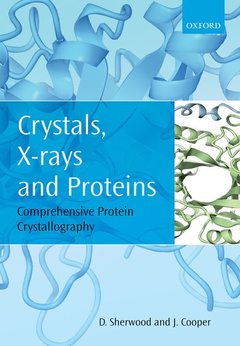Description
Crystals, X-rays and Proteins
Comprehensive Protein Crystallography
Authors: Sherwood Dennis, Cooper Jon
Language: English
Subjects for Crystals, X-rays and Proteins:
Approximative price 70.09 €
In Print (Delivery period: 21 days).
Add to cart
Crystals, X-rays and Proteins
Publication date: 03-2015
644 p. · 24.7x17.1 cm · Paperback
Publication date: 03-2015
644 p. · 24.7x17.1 cm · Paperback
Approximative price 143.18 €
In Print (Delivery period: 21 days).
Add to cart
Crystals, x-rays and proteins: comprehensive protein crystallography (hardback)
Publication date: 11-2010
644 p. · 17.6x24.9 cm · Hardback
Publication date: 11-2010
644 p. · 17.6x24.9 cm · Hardback
Description
/li>Contents
/li>Biography
/li>Comment
/li>
A complete account of the theory of the diffraction of x-rays by crystals with particular reference to the processes of determining the structures of protein molecules, this book is aimed primarily at structural biologists and biochemists but will also be valuable to those entering the field with a background in physical sciences or chemistry. It may be used at any post-school level, and develops from first principles all relevant mathematics, diffraction and wave theory, assuming no mathematical knowledge beyond integral calculus. The book covers a host of important topics in the area, including: - The practical aspects of sample preparation and x-ray data collection, using both laboratory and synchrotron sources - Data analysis at both theoretical and practical levels - The important role played by the Patterson function in structure analysis by both molecular replacement and experimental phasing approaches - Methods for improving the resulting electron density map - The theoretical basis of methods used in refinement of protein crystal structures - In-depth explanation of the crucial task of defining the binding sites of ligands and drug molecules - The complementary roles of other diffraction methods which reveal further detail of great functional importance in a crystal structure.
1. The crystalline state and its study. 2. Vector analysis and complex algebra. 3. Crystal systematics. 4. Waves and electromagnetic radiation. 5. Fourier transforms and convolutions. 6. Diffraction. 7. Diffraction from one-dimensional obstacles. 8. Diffraction from a three-dimensional lattice. 9. The contents of the unit cell. 10. Experimental methods: sample preparatio. 11. Experimental techniques: data collection and analysis. 12. The Phase problem and the Patterson function. 13. Molecular replacement. 14. Solving the phase problem experimentally. 15. Refinement. 16. Complementary crystallographic methods.
Dennis Sherwood read Natural Sciences as a scholar at Clare College, Cambridge, and subsequently won a Mellon Fellowship to the Department of Molecular Biophysics and Biochemistry at Yale University (MPhil), and a Calbiochem Scholarship to the University of California at San Diego (PhD). After a brief period as an ICI Post-doctoral Fellow at the University of Sussex, Dennis changed career, and joined Deloitte Haskins & Sells as a trainee consultant, and where, for 12 years, he was a consulting partner. Dennis was subsequently an Executive Director with Goldman Sachs, a partner in Bossard Consultants, and Managing Director in the UK of SRI Consulting. Dennis now runs his own business, The Silver Bullet Machine Manufacturing Company Limited , which specialises in organizational creativity and innovation. Dennis participates in a number of academic programmes at institutions such as London Business School, the London School of Economics, the University of St Gallen, and London South Bank University. Jon Cooper is a Professor of Structural Biology at UCL Department of Medicine who specialises in expression and X-ray structure analysis of proteins. Previously he was based in the School of Biological Sciences at the University of Southampton where he taught biochemistry and structural biology on undergraduate programmes and at the post-graduate level. He has been working in the protein crystallography field since the mid-1980s when he started a PhD at Birkbeck College London where he later became a post-doctoral fellow and subsequently a lecturer. He is a member of Biological Structures Group of the British Crystallographic Association (BCA) and has been a tutor at the BCA Protein Crystallography Summer School.
The first two-thirds of this book was like a thriller to me. Even though I knew the answer, I wanted to see how the author would address the next topic and I could not put it down.
© 2024 LAVOISIER S.A.S.




